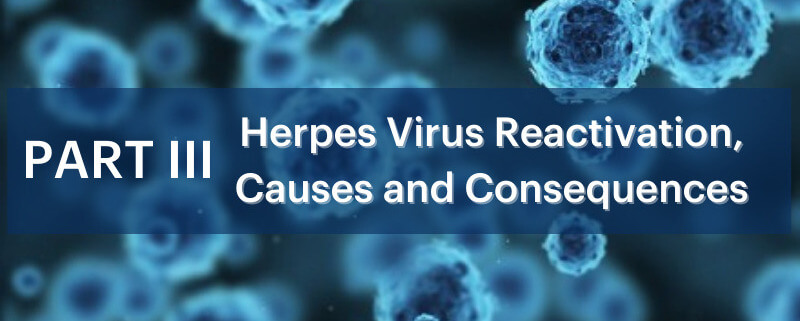INTRODUCTION: This is Part III in a series presenting reports dealing with the reaction of Herpes viruses during the ongoing SARS-CoV-2 pandemic. Numerous articles came out during 2020 linking Varicella-zoster virus (VZV) reactivation which causes Herpes Zoster (HZ) with the pandemic. VZV reactivates in about 1/3 of individuals later in life, after having been infected as a child. During this childhood infection, VZV replication occurs in T-cells which reconfigures the T-cells to become activated memory T-cells with enhanced skin-homing capacity and reduced immune functions1. These VZV-infected T-cells transport the virus to skin and possibly ganglia during the childhood primary infection.
DISCUSSION: Case reports around the world have reported reactivation of HZ in patients infected with COVID-19 (SARS-CoV-2). In a case series from Italy, 4 critically ill elderly patient developed HZ. All 4 patients had lymphopenia, especially decreased CD8+ and CD3+ cells which might have contributed to the cessation of latency2. It is known that CD8+ T-cells maintain Herpes virus latency3. There is an altered immune response during a COVID-19 infection which facilitates the replication of COVID-19 and increases the viral load by causing the natural killer (NK) cells and CD8+ T-cells to become exhausted and hence the coronavirus cannot be eliminated. In particular, Zheng et al4, showed that the number of T-cells and CD8+ T-cells was lower in patients with severe disease than in cases with mild disease. The NK-cell counts were reduced markedly in severe cases. The exhausted NK-cells and CD8+ cells showed an increased expression of the CF94/NK group 2 member A (NKG2A) receptor. Of interest, in patients convalescing after therapy, the number of NK and CD8+ T-cells was restored and concomitantly their NKG2A expression was markedly reduced. They hypothesized that the functional exhaustion of cytotoxic lymphocytes associated with COVID-19 infection breaks down the antiviral immunity, and that the enhanced expression of NKG2A, as specifically observed in CD8+ and NK cells, could contribute to the maintenance of this blunted antiviral surveillance. The secondary effect of eliminating or reducing these cytotoxic T lymphocytes, is that many viruses are no longer suppressed by the host immune system. This has resulted in thousands of cases of HZ, in addition to many other virus reactivation (such as human papilloma virus as well as several other Herpes viruses).
CONCLUSION: Research data shows that both the infection with SARS-CoV-2 and the vaccination against this virus has led to a large increase in Herpes virus reactivations. Perhaps vaccination against HZ (ShingrixTM) could reduce the appearance of HZ from either of these causes.
REFERENCES:
- Laing, K. J., Werner J.D. Ouwendijk, David M. Koelle, and Georges M.G.M. Verjans. (2018). Immunobiology of Varicella-Zoster Virus Infection. Journal of Infect Dis. 218(S2);S68-74. Https://doi.org/10.1093/infdis/jiy403
- Tartari, F., A. Spadotto, C.Zengarini, R. Zanoni, A. Guglielmo, A. Adorno, C. Valanzia, and A. Pileri (2020). Herpes zoster in COVID-19 positive patients. Int. J. Dermatology, 59:1028-1029. https://doi.org/10.1111/jid.15001
- Wei, L., J. Zhao, W. Wu, Y. Zhang, X. Fu, L. Chen, and X. Wang. (2017). Decreased absolute numbers of CD3+ T cells and CD8+ T cells during aging in herpes zoster patients. Scientific Reports, 7:15039. https://doi.org/10.1038/s41598.017.15390.w
Zheng, M., Y. Gao, G. Wang, G. Song, S. Liu, D. Sun, Y. Xu, and Z. Tian. (2020). Functional exhaustion of antiviral lymphocytes in COVID-19 patients. Cellular & Mol. Immunol. 17:533-535. https://doi.org/10.1038/s41423.020.0402.2
MKTG 1063 - Rev A 020322



